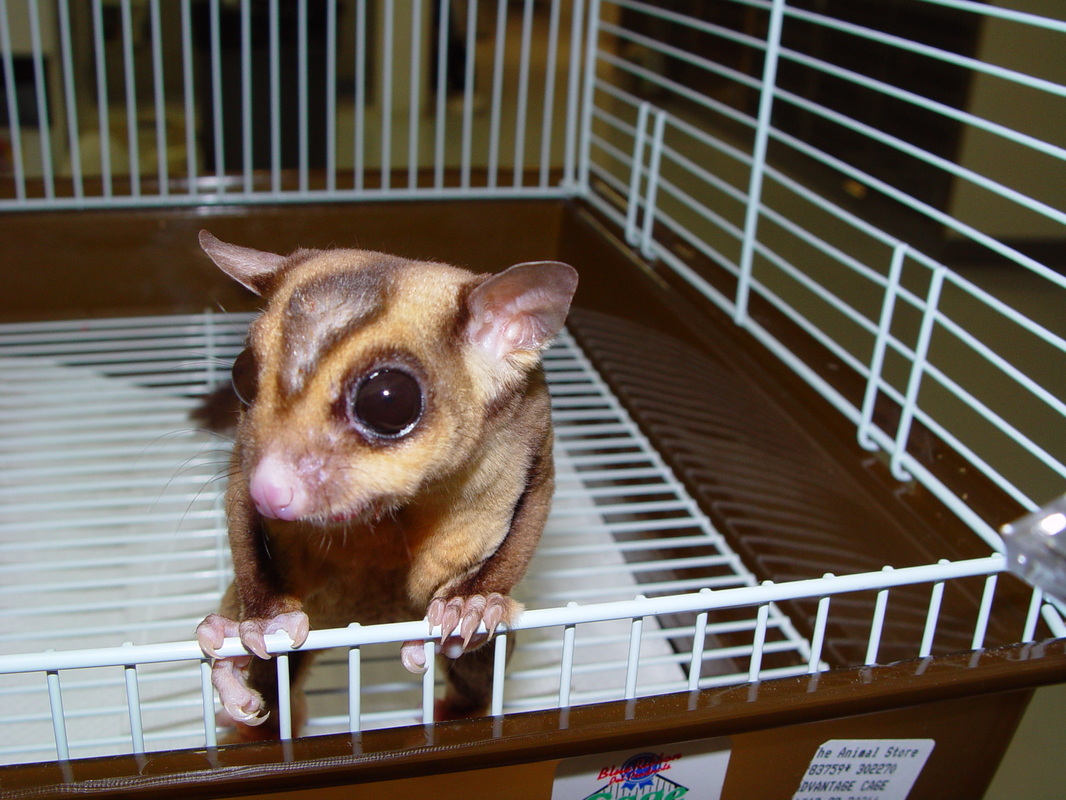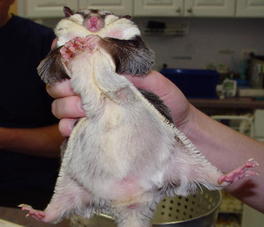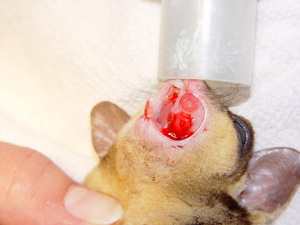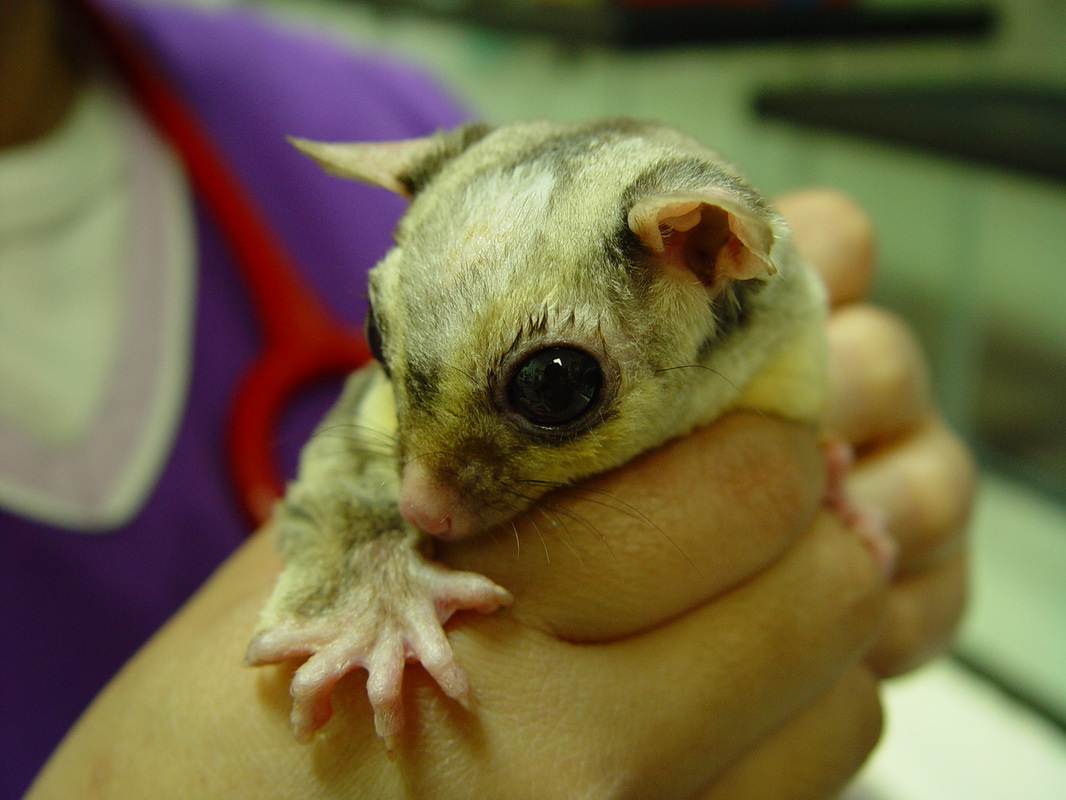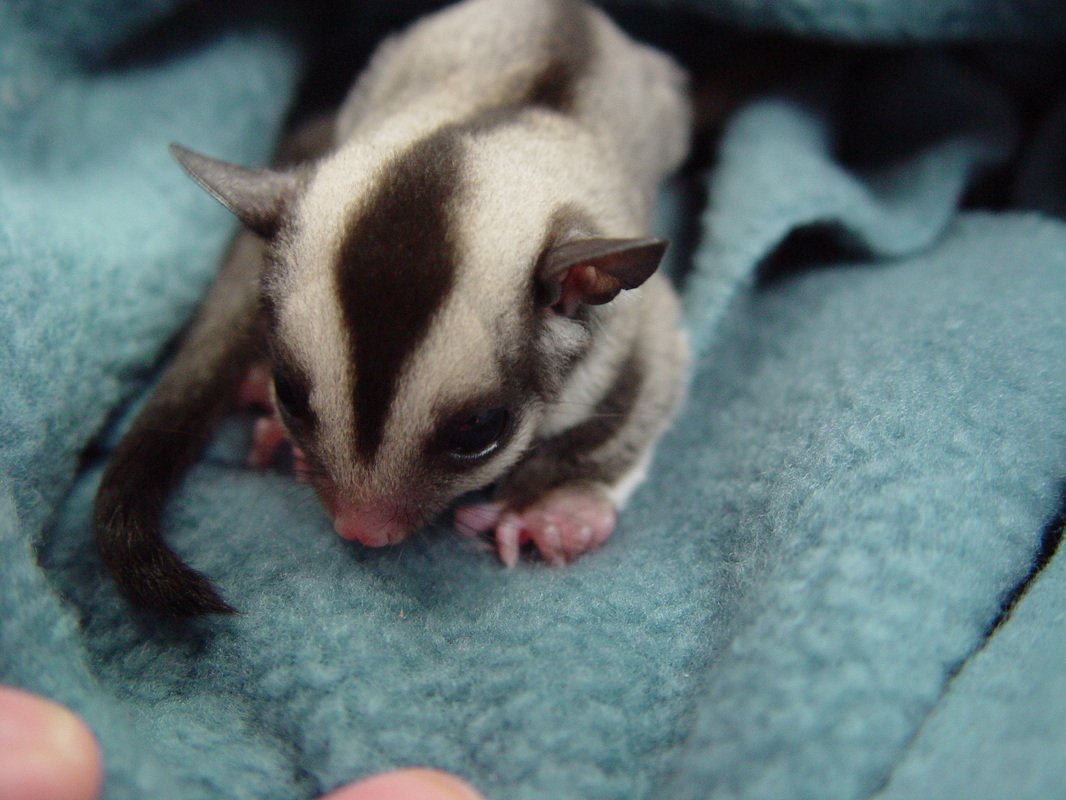Sugar Glider Care
by Deanne Strat-Zenoni, DVM
Pictures by Susan Horton, DVM
Pictures by Susan Horton, DVM
Sugar gliders are marsupials (warm-blooded animals with a pouch like the kangaroo and wallaby). Gliders originate from New Guinea and Southern Australia where they spend most of their time living in the trees. They possess a gliding membrane that stretches from their wrists to their ankles and allows them to “glide” from tree to tree. Sugar gliders are nocturnal animals, which means they spend much of their active time at night and sleep during the day.
They are omnivores i.e. they eat both plant and animal matter. (see diet recommendations) Male gliders have two scent glands used for marking territory. One gland is located on their belly and the other on the top of their head. They will mark objects by rubbing their bellies back and forth upon the object. They will also mark any females in their colony by rubbing the female's chin with their head. Once neutered, these scent glands diminish. Female gliders have a pouch located mid-abdomen. Most sugar gliders will begin breeding somewhere between seven months to a year of age. Like kangaroos, gliders have a very short gestation period of 16 days after which they give birth to one to three hairless offspring that are smaller than a bee. The babies crawl up the fur of the abdomen, enter the mother’s pouch and attach to a nipple where they remain for approximately two to three months. Approximately ten days after emerging from the pouch, the babies open their eyes and a month later they are ready to wean. Note: A license is required to breed sugar gliders.
Housing
A wire cage is preferred and should be 20" X 20" X 20" or larger to provide plenty of space to climb. The wire used is 1" X 0.5" welded wire. Gliders enjoy chewing on wood. It is important to provide natural wood branches in the cage for chewing and climbing. Oak, fruit woods (cherry, apple pear etc.), willow, and aspen are acceptable. Do not use any branch that has been sprayed with
pesticides. You should bake branches at 200 degrees for ½ hour if you bring them in from outside. A nest box should be provided to give the glider(s) a dark place to hide and sleep. The box should be closed on all sides with a hole for entry/exit. Exposure to bright sun can damage their sensitive eyes. Plain white unscented toilet paper or paper towels, hay or aspen chips can be used as bedding. Avoid using cedar or pine shavings or shavings impregnated with chlorophyll. These bedding materials can cause irritation to the eyes, nose, throat, lungs and skin.
Diets for Sugar Gliders (Peters breviceps)*
Below are the most up to date diet recommendations, but are frequently changed as new information is obtained. There is no simple over the counter diet for sugar gliders. The diets are multi-faceted and time consuming. There are several websites that provide good information on husbandry, diets, etc. These websites, while helpful, do not replace regular veterinary care.
http://www.angelfire.com/nb/sugarglider/
www.glidercentral.net
www.sugarglider.com
HPW diet (High Protein Wombaroo Diet)
- 2 cups warm water
- 1 ½ cups honey
- 3 scrambled eggs
- 2 tbsp bee pollen
- ¼ cup High Protein Wombaroo Powder (1/2 cup if breeding/pregnant)
(This product can be found online)
- Cook eggs and set aside
- In large bowl mix water and honey. Stir honey until dissolved. Add in HPW powder and mix well
- Combine ingredients; add egg, bee pollen, and slowly add HPW liquid, blending thoroughly
- Pour into freezer safe bowl with airtight lid. It should freeze to ice cream consistency.
Feed
1 ½ tbsp HPW thawed
1 tbsp fresh or frozen fruit
1 tbsp fresh or frozen veggies
Insects (4-6 crickets OR 4-5 mealworms OR 2 superworms OR 6-8 waxworms)
* Note all insects should be gut loaded and dusted with Rep Cal
Wax worms are fattening and should not be a regular part of the diet
Rotate insects
DO NOT feed lightening bugs
*Be careful with fruit and veggie choices, goal should be a 2:1 Ca:Ph ratio
Do not feed pits, seeds, +/- skins (pesticides)
Avoid grapes and raisins since enough is not known about the effect on the kidneys of sugar gliders
Rotate fruits and veggies, do not be surprised if their tastes change frequently
BML diet (Bourbon’s Modified Leadbeaters diet)
- ½ cup honey (do not use honeycomb, raw or unfuiltered)
- 4oz Premixed Gerber juice with yogurt (mixed fruit or banana)
- ¼ cup wheat germ
- 1 tsp Rep Cal Herptvite (blue label)
- 2 tsp Rep Cal non phosphorus w/ Vit D3 (pink label)
- 2 2 ½oz jars Stage 2 chicken baby food
- 1 hardboiled or scrambled egg
- ¼ cup Apple Juice
- ½ cup dry baby cereal (rice, mixed or oatmeal- many like rice w/ banana flavor)
- Mix honey and juice/yogurt mix and blend well
- Add wheat germ, vitamins, chicken baby food, egg, blend well
- Slowly add Apple juice and baby cereal
- Blend well for 5 minutes
- Pour into Tupperware bowl or ice cube trays and freeze to ice cream consistency
- This mix will feed 1 glider for a month
Feed
1 tbsp BML
1 tbsp fruits
1 tbsp veggies
Insects (4-6 crickets OR 4-5 mealworms OR 2 superworms OR 6-8 waxworms)
* Note all insects should be gut loaded and dusted with Rep Cal
Wax worms are fattening and should not be a regular part of the diet
Rotate insects
DO NOT feed lightening bugs
*Be careful with fruit and veggie choices, goal should be a 2:1 Ca:Ph ratio
Do not feed pits, seeds, +/- skins (pesticides)
Avoid grapes and raisins since enough is not known about the effect on the kidneys of sugar gliders
Rotate fruits and veggies, do not be surprised if their tastes change frequently
There are other diets out there that people use, including some that allow for a “pelleted” diet. In general they should get 33% protein and 67% fruits and veggies in their diet.
Acacia gum allows for a good enrichment tool that can be placed in small drill holes in branches or toys. It can be fed 3-4 times a week. Another good option is a nectar supplement made specifically for gliders.
Good examples of fruits and veggies include: papaya, oranges, bananas, strawberries, cantaloupe, mango, kiwi, peaches, honeydew melon, cucumbers, squash, bell peppers, carrots, sweet potatoes, bok choy, jicama, green beans.
Health Concerns
HLP (Hind Limb Paralysis, Metabolic Bone Disease, Hypocalcemia)
The most common problems seen in gliders are associated with dietary deficiencies of protein and calcium. These deficiencies result from feeding the improper diet. Calcium deficiency may present as loss of appetite and weight loss, lethargy/weakness, tremors, lack of coordination, limping, abnormal heart rate and rhythm, and lameness due to broken bones. Fractures of the spine may occur resulting in paralysis. If changes associated with low calcium are recognized early and treated appropriately with dietary supplementation and correction these pets may recover to normal. Failure to correct the problem usually results in death.
Other diet deficiencies
Protein and vitamin deficiencies can result in poor function of the immune system, cataracts, seizures, star gazing, loss of appetite and weight loss to name a few.
Trauma
Trauma associated with cat and dog attacks is common and can be fatal. In addition, due to the small size of your glider, it may easily escape in to small under cabinets, appliances and under doors to the outside. Monitor your pet closely when outside of the cage.
Self Mutilation
This may result from stress, injury, other and can be very difficult to control. Early intervention is tantamount to preventing this from becoming a chronic concern.
Parasites
Intestinal parasites are common and are most often protozoal. Your veterinarian may prescribe appropriate medications. Regular fecal exams are recommended.
Cancer
Infection
Dental Disease
Pictured below is one obese sugar glider. It is important to balance their diets and provide adequate environmental enrichment to prevent this disorder.
We do see neoplasia in sugar gliders. Also pictured below is an oral tumor. Abscesses can have a similar appearance. If you are seeing anything like this in your sugar glider, you need to call us! 847-329-8709

